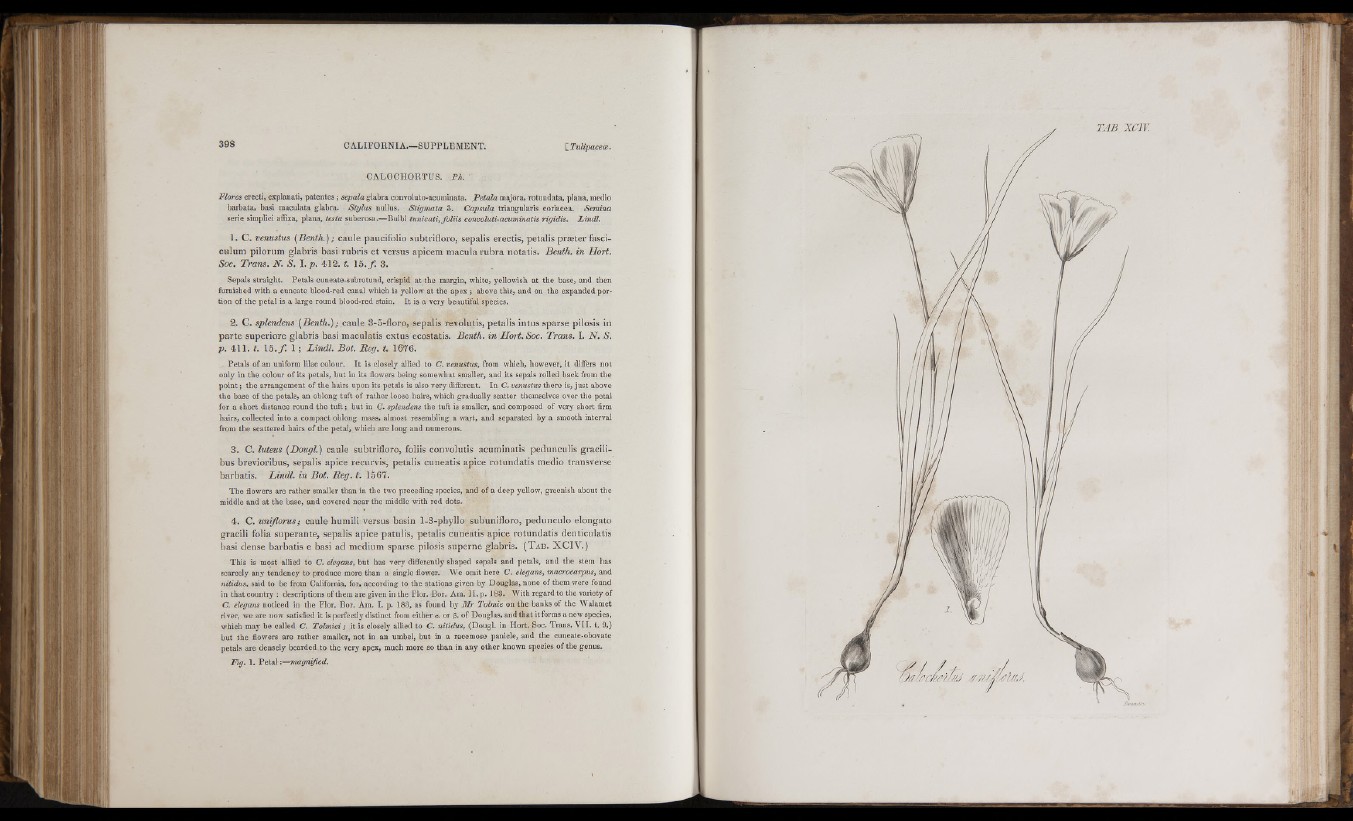
f - 1;
3 9 8 CALIFORNIA SUPPLEMENT.
CALOCHORTUS. Ph.
[TulipacecE.
Flores erecti, esplanati, patentes ; sepala glabra convoluto-acuminata. Petala majora, rotundata, plana, medio
barbata, basi maculata glabra. Stylus nullus. Stigmata 3. Capsula triangularis coriácea. Semina
serie simplici affixa, plana, testa suberosa.—Bulbi tunicati, fo liis convoluti-acuminatis rigidis. Lindl.
1. C. venustus {Benth.); caule paucifolio subtrifloro, sepalis erectis, petalis p ræ ter fasci-
culum pilorum glabris basi ru b ris e t versus apicem macula ru b ra notatis. Benth. in Hort.
Soc. Tra n s. N. S . l .p . 419. t 1 5 . / . 3.
Sepals straight. Petals euoeate-subrotund, crispid at the margin, white, yellowish at the base, and then
furnished with a cuneate blood-red canal which is yellow at the apex ; above this, and on the expanded portion
of the petal is a large round blood-red stain. It is a very beautiful species.
2. C. splendens {Benth.); caule 3-5-floro, sepalis revolutis, p e ta lis in tu s sparse pilosis in
p a rte superiore glabris basi maculatis extus ecostatis. Benth. in Hort. Soc. Trans. I. N . S.
p . 4 11. t. 1 5 . / 1 ; L in d l. Bo t. Reg. t. 1676.
Petals of an uniform lilac colour. It is closely allied to C. venustus, from which, however, it differs not
only in the colour of its petals, but in its flowers being somewhat smaller, and its sepals rolled back from the
point ; the arrangement of the hairs upon its petals is also very different. In C. venustus there is, just above
the base of the petals, an oblong tuft of rather loose hairs, which gradually scatter themselves over the petal
for a short distance round the tuft ; but in C. splendens the tuft is smaller, and composed of very short firm
hairs, collected into a compact oblong mass, almost resembling a wart, and separated by a smooth interval
from the scattered hairs of the petal, which are long and numerous.
3. C. luteus {Dougl.) caule subtrifloro, foliis convolutis acuminatis pedunculis gracilibus
brevioribus, sepalis apice recurvis, petalis cuneatis apice ro tu n d atis medio transverse
barbatis. Lin d l. in Bot. Reg. t. 1567.
The flowers are rather smaller than in the two preceding species, and of a deep yellow, greenish about the
middle and at the base, and covered near the middle with red dots.
4. C. uniflorus; caule humili versus basin 1-3-phyllo subunifloro, pedúnculo elongato
gracili folia supe rante, sepalis apice p atulis, petalis cuneatis apice ro tundatis denticulatis
basi dense barbatis e basi ad medium sparse pilosis superne glabris. (T a b . X C IV .)
This is most allied to C. elegans, but has very differently shajied sepals and petals, and the stem has
scarcely any tendency to produce more than a single flower. We omit here C. elegans, macrocarpus, and
nitidus, said to be from California, for, according to the stations given by Douglas, none of them were found
in that country : descriptions of them are given in the Flor. Bor. Am. II. p. 183. With regard to the variety of
C. elegans noticed in the Flor. Bor. Am. I. p. 183, as found by M r Tolmie on the banks of the Walamet
river, we are now satisfied it is perfectly distinct from either «. or fi. of Douglas, and that it forms a new species,
which may be called C. Tolmiei; it is closely allied to C. nitidus, (Dougl. in Hort. Soc. Trans. VII. t. 9,)
but the flowers are rather smaller, not in an umbel, but in a racemose panicle, and the cuneate-obovate
petals are densely bearded to the very apex, much more so than in any other known species of the genus.
Fig. 1. Petal :—magnified.
TAB xcn:
■ f
i \
■ • i
' tii/:
(■ : 1 -a
■
lil